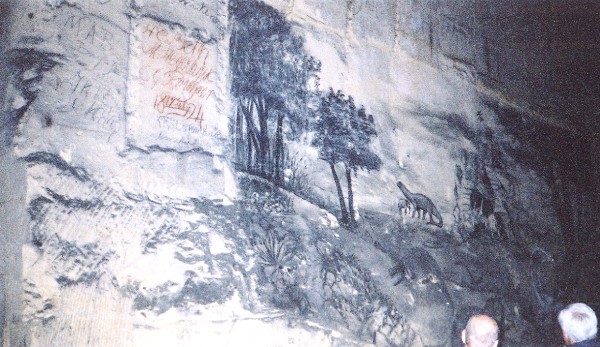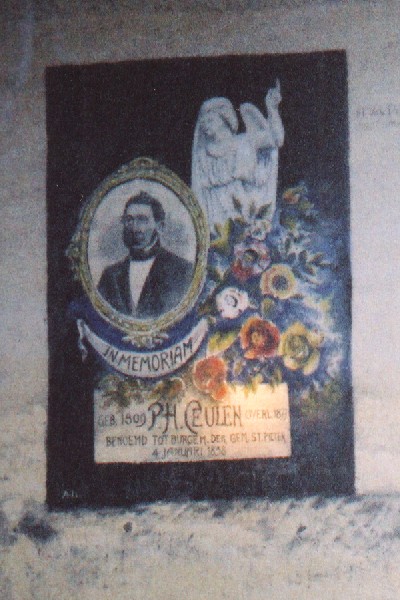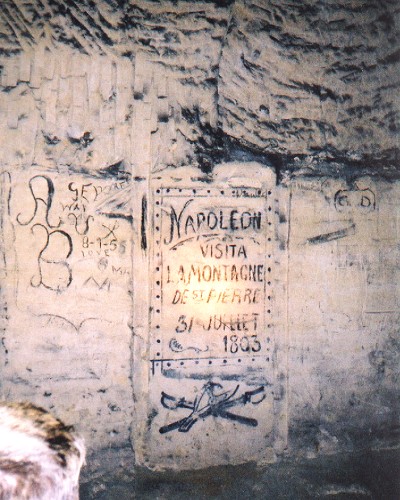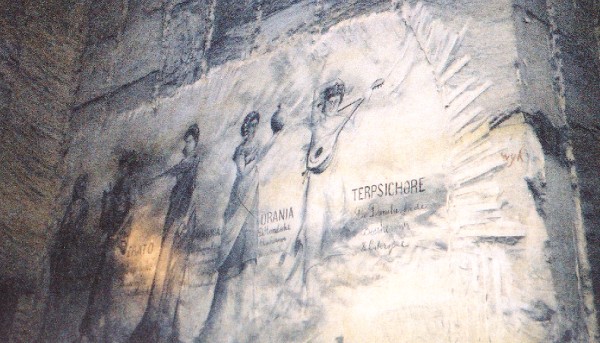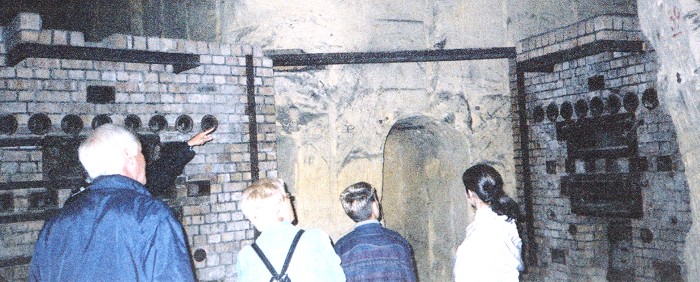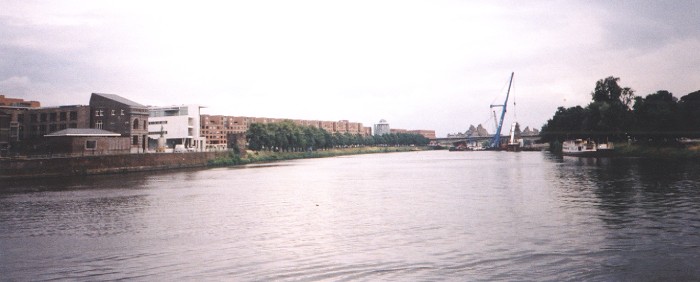|
Everywhere I looked there were endless passages going off in every direction, being intercepted at regular intervals by others crossing over, although the grid structure wasn't completely uniform or straight. Many passages would bend around or go a bit wonky. The walls were covered with artistic creations and the words of thousands of people whose lives had been spent inside. The guide pointed to one spot marked by a plaque where a baby had been born, and decades later that baby was apparently now due to return to the caves and become one of the guides. Also visible in the rock were fossils of all kinds of small land and sea creatures, lodged for eternity. The land had been formed some eighty million years earlier by the accumulation of shellfish remains, and those of other creatures which had inhabited the sea in prehistoric times. Even larger mammals had been discovered, including remains of sharks, giant turtles and reptiles, and a recent find had uncovered a Mosasaurus, which was a lizard believed to be twenty metres long. It was impossible to be totally satisfied with this brief introduction to the caves, because it represented just a fragment of an astonishing secret world. One of the tunnels ran several kilometres underground to Belgium, and it was inconceivable to visualize the vast numbers of workers excavating so much stone, and the huge amount of people whose lives once revolved around this now empty city. Perhaps some of them were still trapped in there, undiscovered. A good deal of all the buildings in Maastricht and elsewhere in Holland had been built with the marlstone quarried from these caves, and after emerging from the hillside and looking back at it, it was odd to think of the vast secret kingdom which lay underneath. It had been one of the most incredible places I had ever visited. Admittedly, much of the hour's trip had been spent traipsing around lookalike tunnels, but the realization of what had once existed there really gripped my imagination. It was a forgotten land; an enormous chunk of history hiding under the surface of the world. It couldn't have been the only such place, but it was surely one of the largest and most spectacular. I had visited many fascinating natural cave systems before, and the man-made Casemates the previous day had seemed exciting enough, but until lunchtime today I had no knowledge that this most phenomenal place existed. Whatever else might happen during my stay, it had been worthwhile coming to Maastricht to see the caves. The return boat journey offered little more of interest than the first trip had. We sailed further down the River Maas past more featureless fields, and did an about-turn on approach to a lock. The river continued from here towards Liège, and more boat trips operated along the whole route. I was in no hurry to book my place. As we turned back towards Maastricht, the pre-recorded audio guide once again thought it necessary to extol the virtues of the cement works. Having paid a lesser price to witness one of the underground wonders of the world, I couldn't see much justification for the money forked out on this boat. Perhaps in my mental weariness of travelling consumption, I had become not only church-weary, museum-weary and mountain-weary, but boat-weary too. After all, I had taken ferries from Newhaven to Dieppe, across the Tagus in Lisbon, and from Algeciras to Tangiers and back. Without those experiences, perhaps this minor league ride would have seemed more exciting. It wasn't Maastricht's fault, I'd been a little unkind about its perfectly adequate tourist offerings. And maybe there was another point here. After a month of touring it might be good to return home, giving me a chance to shake off the familiar routines of life on the line, and to be able to reset my churchometers, boat thrill levels and museum pleasure centres. The next time I journeyed, these attractions would provide fresh, invigorating experiences once more. |
We floated past the provincial government buildings of Limburg, which the easily-pleased audio commentator described as having a splendid modern architectural design, but which to me looked like a monstrous overuse of dreary brown bricks. The egg-shaped extension of the Bonnefantenmuseum again provided the only moment of riverside inspiration, aside from a span of a new bridge being hoisted into place by a crane (above). When the passengers put their feet back ashore, it was no surprise to see a clever money-making opportunity in operation as they reached the end of the gangplank. Spread out over a row of boards were all the photographs taken some hours earlier, and which most people had probably forgotten all about. The idea was obviously to make us coo 'the photo, the photo!' (in Dutch), but it failed to have an effect on me when I saw the extortionate price being demanded of 5 Euros. For that, I would have the treasured memory of leaning with an awkward posture in front of a river on a cloudy day, at the precise moment that I blinked. As I approached the boards I sharply scanned from a distance the array of cheerful groups who occupied the other prints, and there on the end was me, the shut-eyed weirdo, all on my own. I marched briskly past before somebody tried to accost me and thrust it in front of my face. Once I had passed, the lady in charge of the boards saw me and quickly whipped the photo down in her own embarrassment, eager to save the other tourists from witnessing this dreadful picture. Fancy that; a single man going on a boat trip with no adoring partner or smiling child in tow - it would surely be enough to put them off buying their own photos. Further trails around the town of Maastricht inevitably landed me in a supermarket, still my favourite food sanctuary after almost a month abroad. This one held a wealth of delicious and unique offerings, and it was unfair to have to select just a couple of items from so many treats. Holland certainly had some intriguing food though, especially when it came to salads. What anybody else in the world might define as a salad was not evident here. Instead, like so many other products on the shelves, the salads were just composite mixtures of multicoloured pulp. I stood staring at one perishable item in a see-through carton, which comprised a layer of green mushy stuff at the base, a layer of whitish mush sandwiched above that, and was topped with a layer of pink pulp which, with the aid of a microscope, could be seen to contain some strands of fish derivatives. I studied the ingredients on the back, and I could ascertain from my best guesses at Dutch, that this was indeed a salmon salad. There was no obvious vegetation included, everything had been liquidized by national dictate. The Dutch were unable to present any foods for dinner unless all trace of their original form had been shredded for security purposes. An alternative theory I pondered was that standards of dentistry in the Netherlands were so low, half the population had no teeth and were subsequently left with no choice but to pour munch-free mush down their gullets. In extreme cases, toothless persons with irritable throats would have to consume gas-foods, and supermarket shelves would be stocked with tuna and cucumber aerosols. It was no use to me, I wanted solid matter, and I eventually found my reward in the form of yet another taboulé - a pot of pre-cooked, flavoured couscous that had been a staple part of my diet over recent weeks. Even the legendary Pierre Martinet, traiteur of the famed Celeriac Remoulade which had me choking on the steps of the Sacré-Coeur, provided his own twist on this product, but I was steering clear of anything bearing his name. I couldn't steer clear of the souvenir and wig shop though, I just had to pay another visit. It was an unavoidable requirement for me to take some small, lightweight gifts home, and to date this had been an impossibility with my chock-a-block backpack. With only a couple of days' travelling to go, I had shed a couple of bits I no longer needed, and I crammed assorted Dutch tourist tat in its place, invariably featuring windmills and tulips. Already it was early evening, and the rain was once again attempting to break the world bucketing record. There was no point lingering around the sodden streets and I took a bus back to the hostel. I discovered that one disaffected American traveller in my dormitory had been replaced by another. He was more vocal than the previous guy in slamming his own country and stating his desperate, urgent need to relocate to Europe. He said he felt like a European who had been accidentally born into the USA, and he spoke almost apologetically to me about his nation's sins. After the many overbearing tourists from the States who I had encountered in my first few days around Paris, it seemed that I was now being offered some repentance in the final thrusts of my journey, by a series of far more pleasant American citizens. All the bad apples had been and gone, and a string of more enlightening Americans who I had met in Biarritz, Lyon and now Maastricht were making up for the others' shortcomings. Like the guy he had replaced overnight - perhaps in a cunning metamorphosis whilst I slept - this traveller was also particularly fond of Holland and the relaxed, easy life he discovered inside its many coffee shops. He was well stocked up on 'interesting substances', which he acquired with as much glee as the goods I recovered from supermarkets. With so little to do of an evening in the vicinity, unless spending a fortune on taxis was an acceptable sport, the best entertainment suggestion he could muster up was to take a stroll under the damp, darkening skies to Belgium. This was not as crazy an idea as it sounded. The border was less than a mile away, and I could understand his determination to stand astride a spot where one leg would fall foul of an entirely different set of laws to the other. He might have to be careful which side his windpipe occupied when he inhaled, although the laws in Belgium had also supposedly been relaxed somewhat. It would, nonetheless, be an interesting philosophical and legal argument. If a man smoked a legal substance whilst standing with one lung on the other side of a national boundary, where such things were outlawed, would his inhalation into this lung violate any laws? Certainly, a judge could not afford to be half-hearted in his verdict! I left him to explore such matters himself whilst I tucked into my feast. When he returned we had a couple of drinks in the bar, which again was sadly lacking atmosphere. I was worried that my travels were ending with a bit of a whimper, although to be fair, they had never been a box of fireworks in terms of hardcore raving action. I never had any intention for them to be a string of drunken nightclub episodes or high-octane thrills and spills, and being on a tight budget prevented me from indulging in anything more than a set of train rides, cheap attractions, hostel stays and relatively low-key social events. This was, after all, my first major adventure away from home, and I was dipping my feet and testing the European water. Perhaps in future journeys I would be more readied for initiating some explosive activities. We retired to our bunks, and for not the first time amongst those I had met, I was referred to as being much younger than I actually was. I couldn't conceal the fact that I was flattered; I hated turning thirty and felt such an old man for it. But my adventures had injected a youthfulness back into me, which renewed my confidence that the good times were not over yet. I could still afford another decade of faffing about before being condemned to a cul-de-sac in suburbia playing Ray Conniff records. The manner in which my age was established was not so gratifying to my room-mate, however. During our discussions about world affairs, the Netherlands, travelling single and other matters, he had begun a short rant declaring that anybody aged thirty or more should be banned from youth hostels. He was fed up with seeing old gubbers sharing his dormitories. I explained that any such decree would have me out the door too, and he nervously asked how old I was. Upon confirming to him that thirty years had indeed passed me by, he sharply decided to up the figure to fifty, clearly feeling that stating forty - and thereby offering me just another ten years to wrinkle and make my statement of age more apparent - would still cause me some offence. He didn't know where to hide his face, but his dramatic, bumbling U-turn on the subject was a moment to savour. Like his compatriot from the previous night, he faced a dreaded flight back across the Atlantic in a few days to the land he despised with such passion. I could sympathize with his feelings. Although from Britain, I too felt determined to spend more time in mainland Europe for whatever reason. There were many things I felt sure to miss if I moved abroad, and there was much that I loved about my own country, but I would not be the first member of the family to have once thought the same, only to settle happily elsewhere and never look back. I had a burning desire to spend at least a few months living on the continent, and to see life from another angle. Perhaps my time would come. This trip had offered a taster, but only forty-eight hours of it remained before my return to reality. Lights were extinguished in the dormitory, and I bedded down and began dreaming about a new experience. HOSTEL REPORT: Maastricht - NJHC Hostel de Dousberg - see day 27 |
